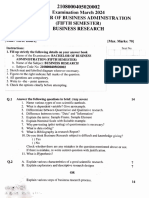0 ratings0% found this document useful (0 votes)
9 views7 Prosocial Behavior
Uploaded by
ayesharehm6Copyright
© © All Rights Reserved
Available Formats
Download as PPTX, PDF, TXT or read online on Scribd
0 ratings0% found this document useful (0 votes)
9 views7 Prosocial Behavior
Uploaded by
ayesharehm6Copyright
© © All Rights Reserved
Available Formats
Download as PPTX, PDF, TXT or read online on Scribd
You are on page 1/ 21
Prosocial Behavior
Defining Prosocial Behavior
Helpful action that benefits
other people without
necessarily providing any
direct benefits to the
person performing the act,
and may even involve a risk
for the person who helps
When a Stranger is Distressed:
Heroism or Apathy?
– Heroism—actions that involve courageous risk-taking to
obtain a socially valued goal
• (e.g., a dangerous act to save a stranger’s life)
– Bystander effect—the likelihood of a prosocial response
to an emergency is affected by the number of
bystanders who are present
• Kitty Genovese’s murder led to research in this area.
– In New York City, 38 people witnessed her being stabbed
to death over a period of 45 minutes, but no one called the
police.
Responding to an Emergency
– Pluralistic Ignorance—tendency of bystanders
to rely on what other bystanders do and say,
even though none of them is sure about what
is happening or what to do about it and this
“information” is used to justify the failure to
act
• Latane and Darley’s (1968) smoke-filled room
experiment showed that people will risk harm to
themselves rather than possibly look foolish.
• This is less likely to happen when people are
friends rather than strangers
• Altruistic Personality—
combination of dispositional
variables associated with
prosocial behavior
– Empathy (feel what the other person
feels)
– Belief in a just world (good deeds get
rewarded)
– Social responsibility (it is one’s duty)
– Internal locus of control (in control of
one’s outcome)
– Low egocentrism (not self-absorbed)
Factors Influencing Prosocial Behavior
1. Situational or external factors influence
helping: Similarity and responsibility
-Helping people we like
-Helping those who are not responsible for their
problem
2. Exposure to live prosocial models
3. Gratitude –how it increases further helping
– Gratitude increases prosocial behavior, primarily
by enhancing helpers’ feelings of self-worth.
4. Emotions and prosocial behavior
–Emotions apply strong effects on the
tendency to help others. Positive feelings
increase this tendency, whereas negative
ones tend to reduce it.
–In addition, feelings of elevation —being
inspired by others’ kind or helpful acts—
increases our own tendency to help.
Motives for Prosocial Behavior or Theoretical
Explanations of Prosocial Motivation
1) Empathy-Altruism
• Empathy: ‘Emotional reactions that are focused on or oriented
toward other people and include feelings of compassion,
sympathy, and concern.’
• Empathy-Altruism Hypothesis: ‘The suggestion that some
prosocial acts are motivated solely by the desire to help someone
in need.’
• It feels good to help others
• Emotional empathy, cognitive component of empathic accuracy
and empathic concern.
2) Negative State Relief
• Negative-state relief model: ‘The proposal that
prosocial behavior is motivated by the bystander’s
desire to reduce his or her own uncomfortable
negative emotions or feelings.’
• Helping sometimes reduces unpleasant feelings.
3) Empathic Joy
• Empathic Joy Hypothesis: ‘The view that helpers
respond to the needs of a victim because they
want to accomplish something, and doing so is
rewarding in and of itself.’
• Helping as an accomplishment.
4) Competitive Altruism
• This view suggests that one important reason why people
help others is that doing so boosts their own status and
reputation and, in this way, ultimately brings them large
benefits, ones that more than offset the costs of engaging
in prosocial actions.
• Status, reputation, people with desirable personal
qualities, social recognition, etc.
• For example; buildings dedicated to their names.
5) Kin Selection Theory
• Kin Selection Theory: ‘A theory suggesting that a key goal for
all organisms—including human beings—is getting our genes
into the next generation; one way in which individuals can
reach this goal is by helping others who share their genes.’
• Helping ourselves by helping people who share our genes.
• Helping people with genetic similarity (close relatives) and
young relatives.
6) Defensive Helping
• Defensive Helping: ‘Help given to members of
outgroups to reduce the threat they pose to the status
or distinctiveness of one’s own in-group.’
• Helping outgroups to reduce their threat to one’s in-
group.
• Defensive helping is performed not primarily to help the
recipients, but rather to “put them down” in subtle
ways and so reduce their threat to the in-group’s status.
Long-Term Commitment To Helping
• Volunteering
– People spend many hours engaging in
voluntary acts that help others.
– Volunteering involves the same steps as
does responding to an emergency.
• Noticing the problem, interpreting it
accurately, assuming responsibility, deciding
how to act, and engaging in the behavior
– Volunteering differs by ethnic group in the
United States
• Whites tend to help animals, the environment,
and emergency personnel.
• African Americans tend to help homeless or
hungry people, groups fighting for civil rights,
and religious institutions.
• Asian Americans tend to help museums and
other artistic and cultural institutions.
• Hispanics tend to help immigrants and people
in other countries.
Long-term Commitment to Helping
• Self-Interest, Moral Integrity, and Moral
Hypocrisy
– People tend to overestimate how often they act
morally and believe that they are more likely to
engage in selfless acts than are most other people.
– Motivation and morality
• Three major motives that affect how someone acts
when faced with a moral dilemma are self-interest,
moral integrity, and moral hypocrisy.
– Self-Interest—motivation to engage in whatever
behavior provides the greatest satisfaction for
oneself
Egoism —exclusive concern with one’s own
personal needs rather than with the needs of
others
– Moral Integrity—motivation to be moral and
actually to engage in moral behavior
– Moral Hypocrisy—motivation to appear moral
while doing one’s best to avoid the costs involved
in actually being moral
You might also like
- 7 Prosocial Behavior 1 30112023 101059amNo ratings yet7 Prosocial Behavior 1 30112023 101059am21 pages
- Module 7 - Psy 312 - Altruism and Prosocial BehaviorNo ratings yetModule 7 - Psy 312 - Altruism and Prosocial Behavior6 pages
- The Basics of Prosocial Behavior: Unit III: Social Literacy Lesson 2: Prosocial and Intercultural CommunicationNo ratings yetThe Basics of Prosocial Behavior: Unit III: Social Literacy Lesson 2: Prosocial and Intercultural Communication9 pages
- The Basics of Prosocial Behavior: Unit III: Social Literacy Lesson 2: Prosocial and Intercultural CommunicationNo ratings yetThe Basics of Prosocial Behavior: Unit III: Social Literacy Lesson 2: Prosocial and Intercultural Communication9 pages
- Altruism: Are We Inherently Selfish? Can We Learn To Act Otherwise?67% (3)Altruism: Are We Inherently Selfish? Can We Learn To Act Otherwise?16 pages
- Chapter 13 - Altruism and Prosocial Behavior-2No ratings yetChapter 13 - Altruism and Prosocial Behavior-27 pages
- Chapter 10_ Prosocial Behaviour - Why Do People HelpNo ratings yetChapter 10_ Prosocial Behaviour - Why Do People Help27 pages
- Social Relations: Helping Others: Lecture 35/ Textbook Chapter 9No ratings yetSocial Relations: Helping Others: Lecture 35/ Textbook Chapter 928 pages
- Week 05. Intragroup processes - PrintableNo ratings yetWeek 05. Intragroup processes - Printable30 pages
- Altruism: Presented by Clinical Psychologist Sadaf SajjadNo ratings yetAltruism: Presented by Clinical Psychologist Sadaf Sajjad38 pages
- Psychology Express - Social Psychology - Jenny Mercer - 2011 - Prentice Hall - 9780273737193 - Anna's Archive-122-139No ratings yetPsychology Express - Social Psychology - Jenny Mercer - 2011 - Prentice Hall - 9780273737193 - Anna's Archive-122-13918 pages
- Materi 4 - Prosocial Behavior - Bu LiliNo ratings yetMateri 4 - Prosocial Behavior - Bu Lili13 pages
- COURSE OUTLINE IN EVIDENCE 2nd-sem-2024-2025_250123_213124No ratings yetCOURSE OUTLINE IN EVIDENCE 2nd-sem-2024-2025_250123_21312411 pages
- Penelitian Kualitatif Dalam Ilmu BotaniNo ratings yetPenelitian Kualitatif Dalam Ilmu Botani25 pages
- Developing Leaders Questions With Correct AnswersNo ratings yetDeveloping Leaders Questions With Correct Answers3 pages
- Character Traits List Horizontal Alphabetical Order Grey Pink Green Beige SaturdayGiftNo ratings yetCharacter Traits List Horizontal Alphabetical Order Grey Pink Green Beige SaturdayGift4 pages
- Europe Agricultural Tractors Market 1722322389251No ratings yetEurope Agricultural Tractors Market 172232238925142 pages
- The Discriminant Validity of Honesty-Humility A Meta-Analysis of The HEXACO, Big Five, and Dark TriadNo ratings yetThe Discriminant Validity of Honesty-Humility A Meta-Analysis of The HEXACO, Big Five, and Dark Triad14 pages
- Moral Development and Reality: Beyond the Theories of Kohlberg, Hoffman, and Haidt 4th Edition John C. Gibbs 2024 Scribd Download67% (3)Moral Development and Reality: Beyond the Theories of Kohlberg, Hoffman, and Haidt 4th Edition John C. Gibbs 2024 Scribd Download51 pages
- Grateful, Gratitude, Gratuitous - English Vocabulary ExerciseNo ratings yetGrateful, Gratitude, Gratuitous - English Vocabulary Exercise6 pages
- مستوى النمو الأخلاقي لدى عينة من طلبة جامعة عمار ثليجي بالأغواطNo ratings yetمستوى النمو الأخلاقي لدى عينة من طلبة جامعة عمار ثليجي بالأغواط20 pages
- Peran Art (Asisten Rumah Tangga) Bagi Anak Ketika Ibu Bekerja (Studi Kasus Asrama Kabupaten Terandam Tni-Ad Padang Timur)No ratings yetPeran Art (Asisten Rumah Tangga) Bagi Anak Ketika Ibu Bekerja (Studi Kasus Asrama Kabupaten Terandam Tni-Ad Padang Timur)10 pages
- Prosocial Behavior Questionnaire (1-107)No ratings yetProsocial Behavior Questionnaire (1-107)21 pages























































































